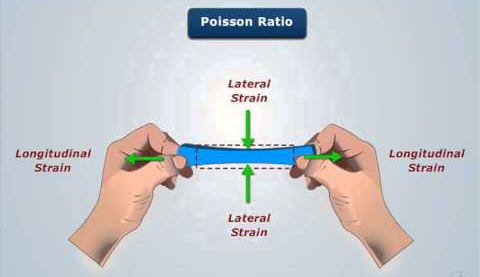The Poisson’a cons ratio is stant for the materials that is used for relating the stress in the one direction, to the elastic strain in another one. The stress usually describes the externally applied force to the materials and the strain is the measurement of the change in the shape due to the applied force.

Importance of Poisson’s Ratio
The Poisson’s ratio is used to measure the Poisson’s effect, which is a phenomenon in which the materials extend in the perpendicular directions, to the direction of the compression. Conversely, if there is stretching of the material rather than the compression, then usually a contraction is observed in the direction’s transverse to the stretching directions. Commonly, it is observed that the rubber band becomes thinner when it is rubbed. Here the Poisson’s ratio will be the ratio between the relative contraction and relative expansion. In some rare cases, the actual shrinking of the material can also be observed in the transverse direction when either stretched or compressed. Resultantly, a negative value of the Poisson’s ratio will be yielded.

Positive and Negative Values of the Poisson’s Ratio
The Poisson’s ratio in the linear elastic, isotropic and the stable material should be between 1 and +0.5, due to the requirements of Young’s modulus, Bulks modulus, and shear modulus to have the positive values. The negative Poisson’s ratio is displayed by some materials known as the auxetic materials. In the longitudinal axis, when these materials are subjected to the positive strain, then in actual the transverse strain in the material will be positive. In other words, the cross-sectional area of the materials will be increased. In these materials, the molecular bonds are hinged and due to this reason, the Poisson’s ratio is uniquely oriented. For stretching of the bonds in the longitudinal direction, the hinges should open in the transverse direction, which in turn will effectively exhibit a positive strain.
Applications of Poisson’s Effects
The Poisson’s effect has considerable influence and uses in the pressurized pipe flow. When the liquid or air inside the pipe is highly pressurized, then a uniform force is exerted on the inner side of the pipe, which causes the hoop stress in the pipe material. Due to this reason, the diameter of the pipe will be increased and the length will be slightly decreased. Poisson’s effect also has significant importance in the realm of structural geology. Under the stressed conditions, most of the rocks are subjected to the Poisson’s effect. As a result, the changes in the strain in the horizontal direction will affect the dormant stresses in the rocks.